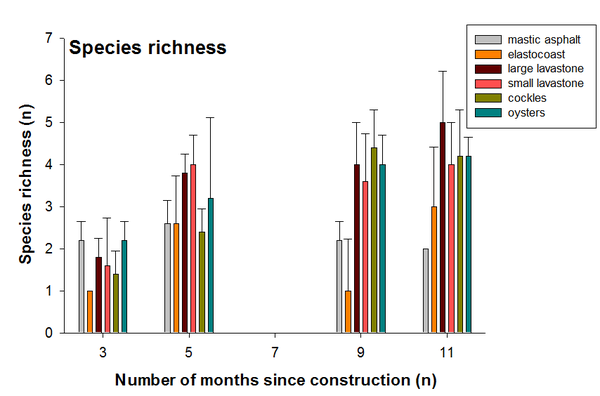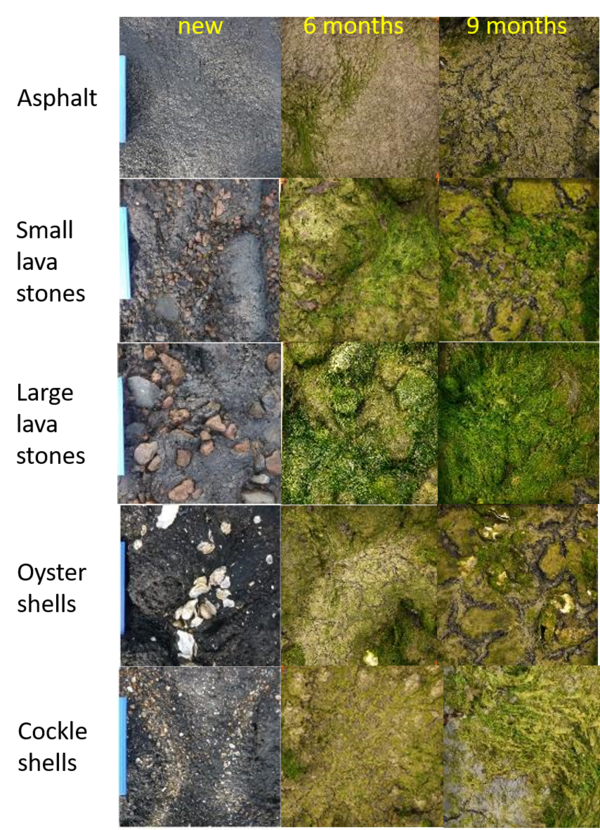| Bfn Data mastic asphalt | |
|---|---|
| Context | Bfn Building for Nature project |
| Type | Outcome |
| Decompositie type | IOR |
Field experiment at Yerseke

Figure 2 illustrates the coverage of species (flora and fauna) over time in %. After 3 months average coverage per substrate is around 50% and high standard deviations (3-36%) indicate that differences between the tiles of the same substrate were large. Coverage has decreased slightly after 5 months due to the loss of Ectocarpus sp. that puts a brown layer on many of the tiles (observations during monitoring). After 9 and 11 months, coverage starts to increase especially in the substrates with lava stone (small and large) and shells (oyster and cockles). Both mastic asphalt and Elastocoast stay behind in coverage with average coverage of respectively 13 and 23%.

Shapiro-Wilkins test shows that the total coverage of T4 was not normally distributed after transformation (P<0.05). A Kruskal-Wallis test showed that there was a significant difference between the total coverage of the different substrates after 11 months (P=0.001). Post-hoc pairwise comparisons show that the total coverage of mastic asphalt differs significantly from that of both small lava stone (P=0.021) and cockle shells (P=0.012). Together with the coverage shown in Figure 2 these results shows that small lava stone and cockles both have a significantly higher coverage of total flora and fauna than mastic asphalt.

The Shannon-diversity index gives a measure of the species diversity in a community, taking into account both the relative abundance and richness of species. The Shannon-diversity index was found to be highest for large lava stone and lowest for Elastocoast and cockle shells. An ANOVA on the Shannon-diversity indices of the substrates after 11 months showed that there was a significant difference in community diversity between the substrates. Post-hoc comparisons showed that the Shannon-diversity found on large lava stone was significantly different from the Shannon-diversity found on Elastocoast (P=0.012) and cockle shells (P=0.048). Figure 3 gives a visual of these differences and shows that both the richness and relative abundance of species found on large lava stone after 11 months is quite high relative to specifically the relatively lower richness found Elastocoast and the large differences in species abundance (dominated by Ulva sp.) on cockle shells.
For more results of this experiment see Vergouwen et al. (2017), paragraph 3.1.
Dike monitoring study at De Val (Zierikzee)
Of the different mastic asphalt substrates, those with lava rocks (small and large) and the reference (bare mastic asphalt) remained relatively intact with no obvious disintegration of the substrate material. However the amount of shells in the oyster and cockle shells treatments decreased considerably after six months in the field. These may have eroded away, and/or become dislodged from the asphalt.
Using the photographs of quadrats, the main species of algae observed on the mastic asphalt from the photos were (to varying degrees): Ulva sp., Fucus sp. and Porphyra sp.. Using ArcGIS to analyse the photos, these three species were identified and their spatial coverage calculated. After nine months in the field there were some obvious differences in the type and amount of algal growth on the different substrate types (figure 4).

Ulva sp. was obviously the most common algae species on the mastic asphalt, and was present in the first monitoring period six months after the application of the asphalt. In contrast, the brown algae, Fucus vesiculosus was first observed in Sept 2016, nine months after the application of the asphalt in the quadrat photos. F. vesiculosis. was most commonly observed on the mastic asphalt treated with small lava stones, cockle shells and large lava stones.
For more results of this experiment see Vergouwen et al. (2017), paragraph 3.2.
De View-Navigation (VN) pagina's.
De links naar andere pagina's.
| Onderdeel van | Bfn Designing and researching ecological potential mastic asphalt |
|---|---|
| Instantie van | |
| Betreft |
De pagina's die linken naar deze pagina.
Dit element heeft geen subelementen. Naar dit element wordt niet geconnecteerd.






